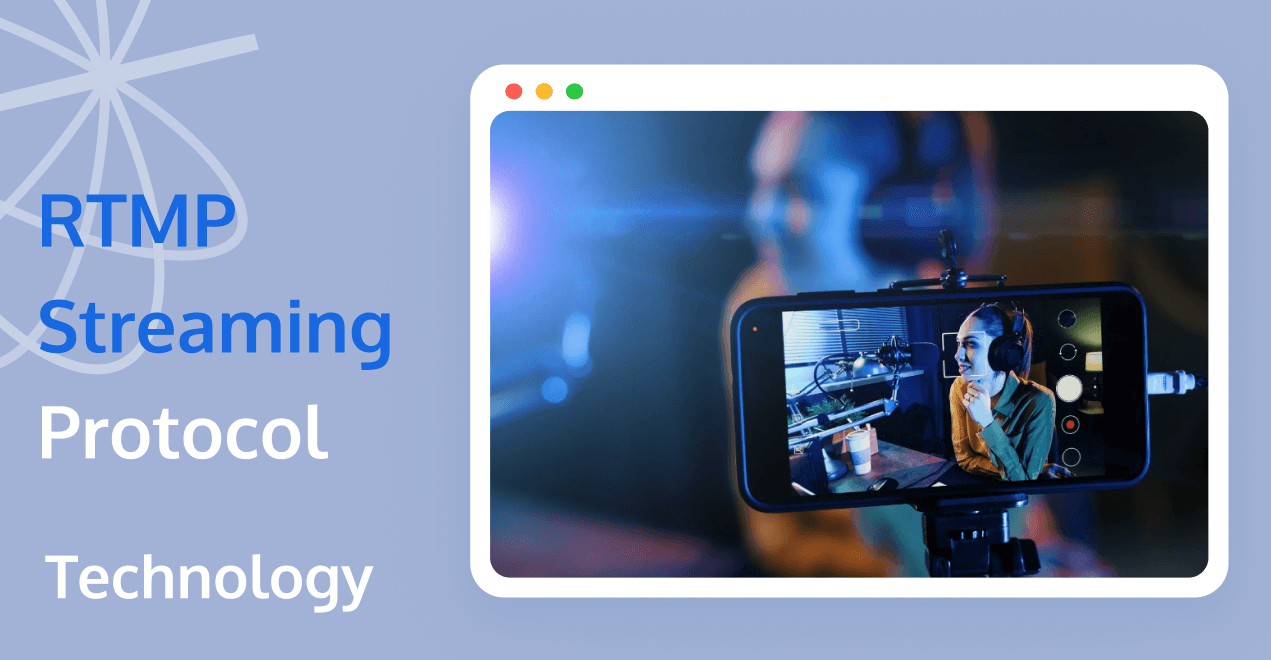
Imagine tuning into a live sports game or an online concert and seeing the action unfold in real time. This seamless experience is often powered by a technology called RTMP, or Real-Time Messaging Protocol.
RTMP is a key player in live streaming, ensuring that your favorite live content reaches you quickly and smoothly. In this guide, we'll dive into what RTMP is, explore its benefits, and show you how it works. Whether you're a casual viewer or a streaming enthusiast, understanding RTMP can enhance your streaming experience.

What is RTMP?
RTMP stands for Real-Time Messaging Protocol. Originally developed by Macromedia (now part of Adobe), it's designed to transmit audio, video, and data over the internet. RTMP excels in live streaming because it minimizes latency and ensures smooth performance, making it ideal for live events, online gaming, and interactive broadcasts. It operates over TCP (Transmission Control Protocol), which guarantees that data arrives reliably and in the correct order.
Advantages of RTMP
RTMP offers several advantages that have contributed to its widespread use:
1. Low Latency
RTMP offers low latency streaming, making it perfect for live broadcasts where immediate feedback is crucial. This is especially valuable for live sports, gaming, and interactive sessions.
2. High Quality
It supports high-quality audio and video, ensuring a clear and smooth viewing experience. This quality makes it suitable for professional broadcasts and high-definition streaming.
3. Flexibility
RTMP works with various media formats and codecs, and supports adaptive bitrate streaming. This adaptability helps maintain stream quality based on the viewer's internet connection.
4. Compatibility
Despite newer streaming protocols, RTMP remains compatible with many platforms and devices, ensuring broad accessibility for streamed content.
What is RTMP Streaming?
RTMP streaming involves sending audio, video, and data over the internet using the Real-Time Messaging Protocol. This method is known for its low latency and ability to support live interactions. In RTMP streaming, media content is captured by a source like a camera or video encoder, sent to an RTMP server, processed, and then distributed to viewers in real-time. It’s commonly used for live events, online gaming, webinars, and other interactive broadcasts.
How Does RTMP Streaming Work?
RTMP, or Real-Time Messaging Protocol, is essential for live streaming and online video platforms. Here's a simplified breakdown of how it works:
- Handshake: This is the first step where the client (like your streaming software or device) and the server (which hosts the stream) establish a connection. They exchange three packets of data to agree on the RTMP version and synchronize their clocks. This ensures both sides are ready to start streaming.
- Connection: Once the handshake is complete, the client sends a request to the server using Action Message Format (AMF) messages. These messages include information like the connection URL and the types of audio and video formats being used. If the server approves the request, the connection is established, and the server is set to receive the incoming stream.
- Stream: With the connection in place, the actual streaming begins. The client sends audio and video data to the server, which then distributes it to viewers. RTMP also supports commands like creating a stream, playing, seeking, or pausing the content, giving the broadcaster control over the streaming experience.
In summary, RTMP ensures a smooth streaming experience by first setting up a connection, then allowing the actual media to be transmitted and controlled.
What Platforms Accept RTMP Streaming?
Several popular platforms accept RTMP streaming, making it easy for you to broadcast live video. Here are a few of the main platforms:
YouTube Live
YouTube lets you stream live video using RTMP. This is great for reaching a large audience and interacting with viewers during your broadcast.
Twitch
Known for gaming and live events, Twitch uses RTMP for streaming. It's popular with gamers and content creators who want to share their gameplay or other live activities.
Facebook Live
You can use RTMP to stream live videos on Facebook. This is useful for broadcasting events, updates, or live interactions with friends and followers.
Vimeo Livestream
Vimeo offers RTMP streaming for professional-quality broadcasts. It's used for business events, conferences, and other high-profile live streams.
DLive
A decentralized streaming platform that uses RTMP. It's known for giving content creators more control and sharing revenue directly with their audience.
How Do I Set Up RTMP?
Setting up RTMP (Real-Time Messaging Protocol) can vary depending on the platform or software you're using, but the general steps are similar. Here’s a broad outline of how to set it up:
1. Choose an RTMP Encoder: Use software like OBS Studio or Streamlabs OBS to capture and compress your media content.
2. Configure Encoder Settings: Adjust the encoder settings to match your streaming needs and input the RTMP server URL and stream key from your streaming platform.
3. Connect to RTMP Server: Enter the RTMP server URL and stream key into your encoder.
4. Start Streaming: Begin your stream in the encoder. The media content will be sent to the RTMP server, which will distribute it to viewers.
5. Monitor and Adjust: Check your stream’s performance and make adjustments as needed to ensure optimal quality.
How Do I Live Stream with RTMP Interworking Via TRTC?
TRTC (Tencent Real-Time Communication) is a powerful platform designed for real-time video and audio streaming. It provides tools for managing live streams, ensuring low latency and high-quality performance.
If you're looking to use RTMP (Real-Time Messaging Protocol) with TRTC (Tencent Real-Time Communication), here's a straightforward guide to help you set up and start streaming.:
1. Using OBS:
- Install OBS: Ensure you have OBS installed.
- Select Source: Add a source such as Media Source, Window Capture, or Video Capture Device.
- Set Publishing Parameters: Configure the stream URL in OBS with the TRTC RTMP URL format.
- Configure Output: Set video encoding parameters to remove B-frames, and adjust keyframe interval, CPU usage preset, profile, and other settings.
- Set Video Parameters: Choose resolution and frame rate for clarity and smoothness.
- Configure Advanced Settings: Disable Stream Delay and keep Automatic Reconnect enabled.
- Start Streaming: Click "Start Streaming" in OBS.
2.Using FFmpeg:
- Install FFmpeg: Ensure FFmpeg is installed and configured.
- Command for Publishing: Use FFmpeg commands with the required parameters:
- FFmpeg commands: ffmpeg [global_options] {[input_file_options] -i input_url} ... {[output_file_options] output_url}
- Playback: Ensure playback using the string-type Room ID on other clients.
3. Playback on Other Clients:
- Streams can be played back on various TRTC clients or web browsers by entering the room with the correct string-type Room ID.
Conclusion
RTMP remains a vital technology for live streaming due to its low latency and reliable performance. Understanding what RTMP is, its advantages, and how it works can help you leverage this protocol for your streaming needs. Whether you're setting up RTMP for personal use or professional broadcasting, the ability to stream high-quality, real-time content is within your reach.
FAQs
What is an RTMP encoder?
An RTMP encoder is software or hardware that captures and compresses video and audio for streaming. It converts the raw content from your camera or computer into the RTMP format, making it ready to send to an RTMP server. Popular encoders include OBS Studio and Streamlabs OBS, which are used for live streaming.
Is RTMP obsolete?
RTMP isn’t completely obsolete but has been largely replaced by newer protocols like HLS and DASH for on-demand video. However, it’s still widely used for live streaming because of its low latency and reliable performance. Many platforms and services continue to support RTMP for real-time broadcasts.
What are the steps in the RTMP process?
The RTMP process involves several steps: First, an RTMP encoder captures and compresses video and audio. Next, it sends this data to an RTMP server. The server processes and formats the content and then distributes it to viewers. Finally, viewers watch the live stream on their devices with minimal delay.
If you have any questions or need assistance online, our support team is always ready to help. Please feel free to Contact us or join us on Telegram or Discord.


